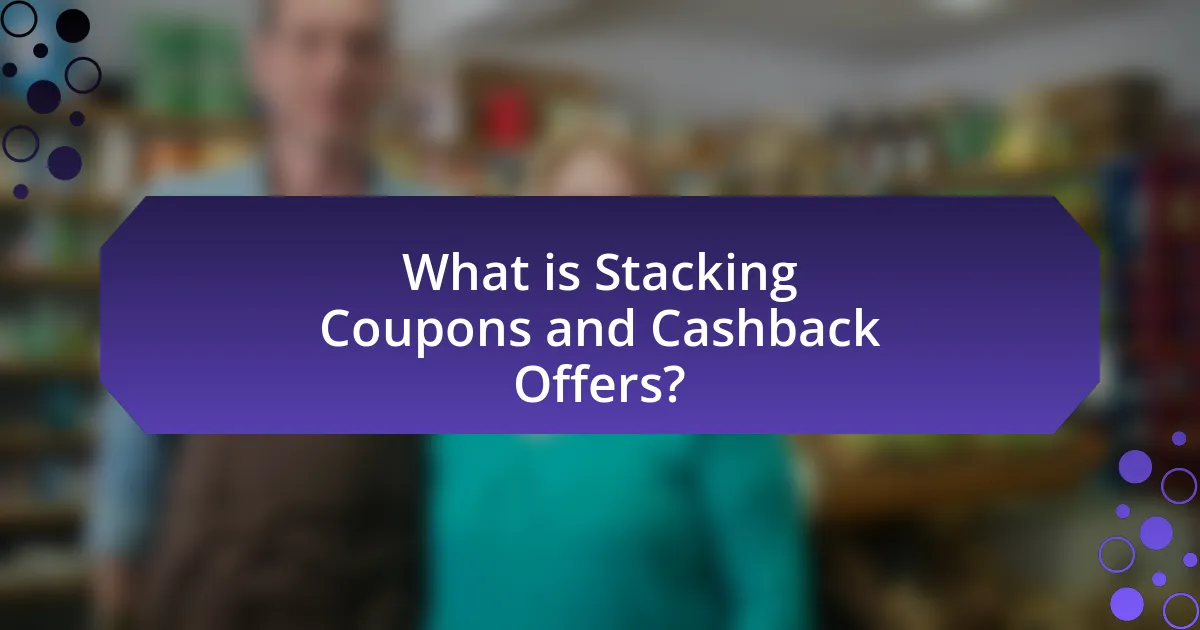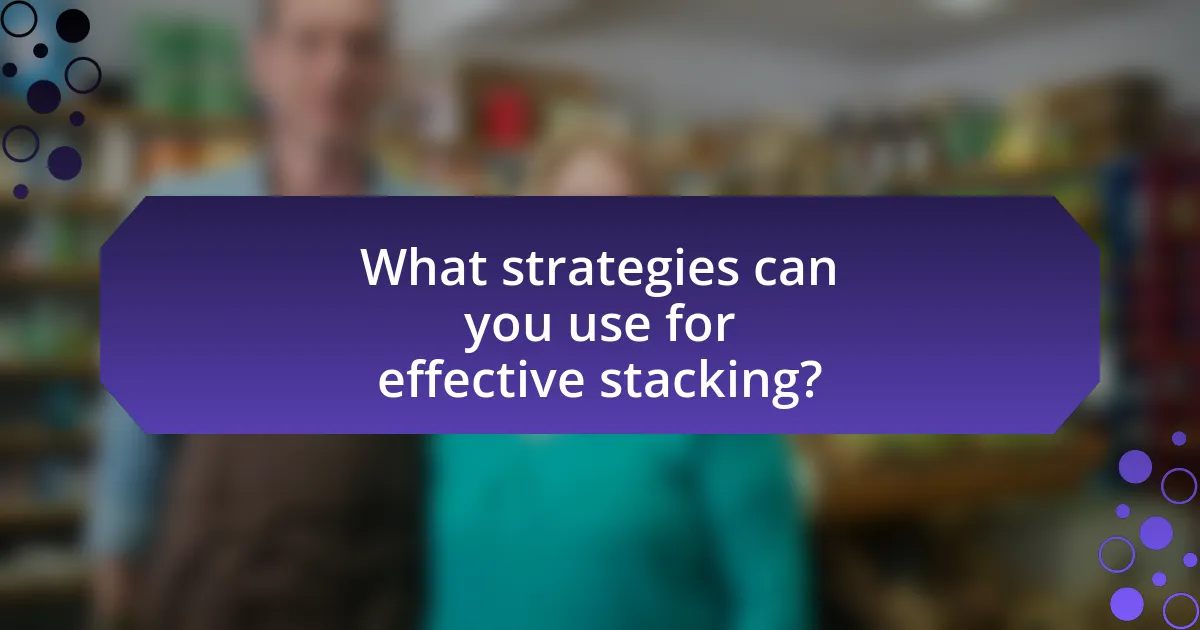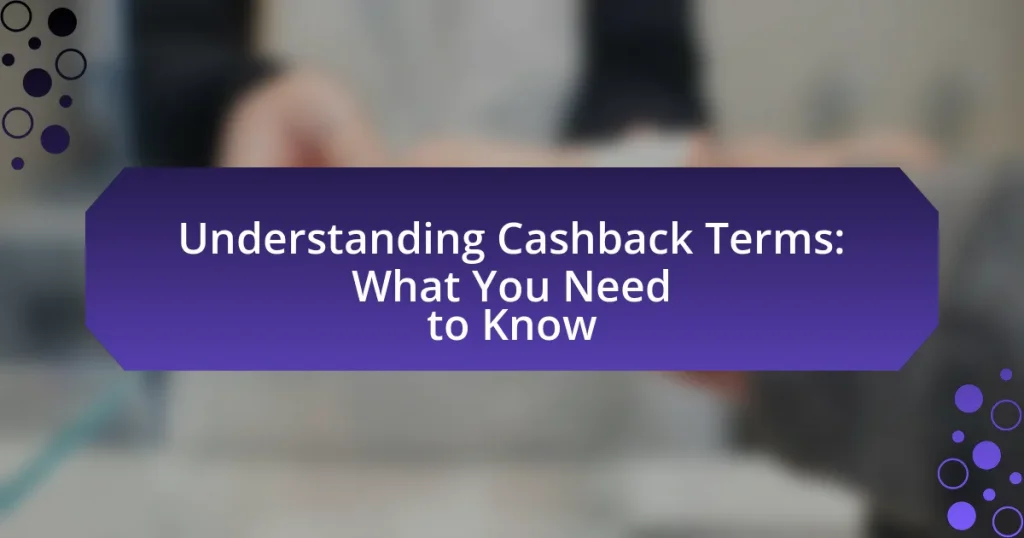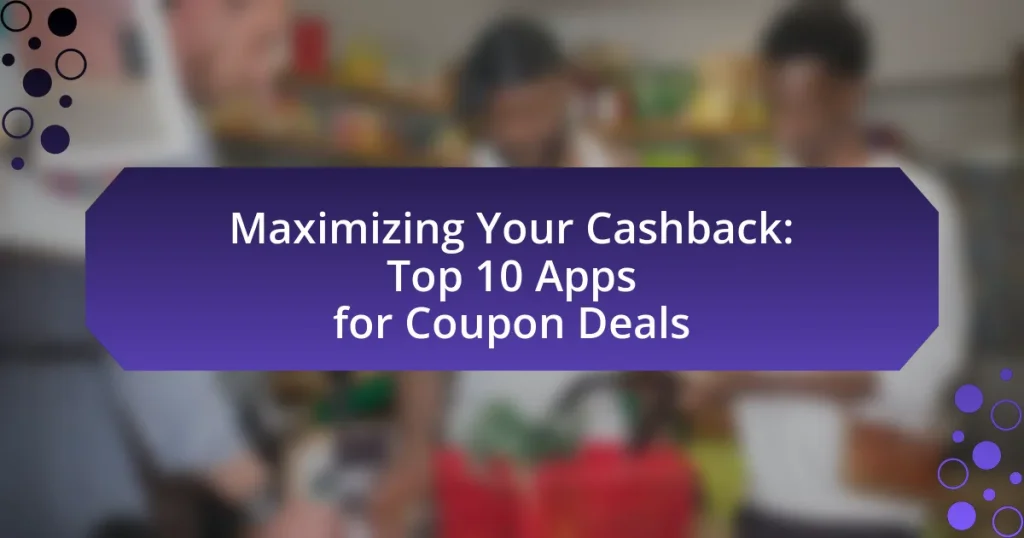Stacking coupons and cashback offers is a strategy that enables consumers to combine multiple discounts and rebates to maximize savings on purchases. This article outlines how stacking works, the key components involved, and the benefits it provides, such as potential savings of up to 50% or more. It also discusses effective strategies for stacking, including understanding store policies, timing purchases, and utilizing various tools and apps to track offers. Additionally, the article highlights common mistakes to avoid and practical tips for successful stacking, ensuring consumers can optimize their shopping experience and achieve significant financial benefits.

What is Stacking Coupons and Cashback Offers?
Stacking coupons and cashback offers refers to the practice of using multiple discounts and rebates simultaneously to maximize savings on a purchase. This strategy allows consumers to apply a coupon for a percentage off the total price while also receiving cashback from a retailer or a cashback app, effectively reducing the overall cost of the transaction. For example, if a shopper uses a 20% off coupon on a $100 purchase, they save $20, and if they also receive $10 cashback, their total savings amount to $30, resulting in a final cost of $70. This method is popular among savvy shoppers looking to optimize their spending and take advantage of various promotional offers available in the market.
How does stacking coupons and cashback offers work?
Stacking coupons and cashback offers works by allowing consumers to apply multiple discounts and rebates to a single purchase, maximizing their savings. When a shopper uses a coupon for a percentage off the total price and also qualifies for a cashback offer from a retailer or a cashback app, both discounts can be applied sequentially. For example, if a product costs $100 and a shopper uses a 20% off coupon, the price reduces to $80. If the shopper then receives a $10 cashback on that purchase, the total effective cost becomes $70. This method is supported by many retailers’ policies that permit the combination of promotional offers, enhancing the overall savings experience for consumers.
What are the key components of stacking coupons and cashback offers?
The key components of stacking coupons and cashback offers include the use of multiple discount types, understanding store policies, and timing purchases strategically. Multiple discount types refer to combining manufacturer coupons, store coupons, and cashback offers from apps or websites to maximize savings on a single purchase. Understanding store policies is crucial, as some retailers have specific rules regarding the stacking of discounts, which can vary widely. Timing purchases strategically involves taking advantage of sales events or promotional periods when additional discounts can be applied, enhancing overall savings. These components work together to create a comprehensive approach to maximizing savings through effective coupon and cashback stacking.
How do different types of coupons and cashback offers interact?
Different types of coupons and cashback offers can interact synergistically to maximize savings for consumers. When a shopper uses a coupon, it typically reduces the purchase price of an item, while cashback offers provide a percentage of the purchase amount back to the consumer after the transaction. For example, if a product costs $100 and a shopper applies a $20 coupon, the effective price becomes $80. If there is also a 10% cashback offer on the original price, the shopper would receive $10 back, resulting in a total savings of $30. This stacking of discounts and cashback is a common strategy that enhances overall savings, as evidenced by consumer behavior studies indicating that shoppers who utilize both methods report higher satisfaction and savings.
What are the benefits of stacking coupons and cashback offers?
Stacking coupons and cashback offers maximizes savings by allowing consumers to combine multiple discounts on a single purchase. This practice enhances the overall reduction in price, leading to significant financial benefits. For instance, a study by the National Retail Federation indicates that consumers can save an average of 20% more when utilizing both coupons and cashback offers simultaneously compared to using either one alone. Additionally, stacking these offers can encourage consumers to purchase items they may not have considered, ultimately increasing their overall savings and satisfaction with their shopping experience.
How much can you save by stacking these offers?
Stacking offers can lead to savings of up to 50% or more on total purchases. For instance, if a product costs $100 and you apply a 20% coupon along with a 10% cashback offer, the total savings would amount to $30, resulting in a final price of $70. This method of combining discounts is supported by various consumer studies, which indicate that strategic stacking of coupons and cashback can significantly enhance overall savings, often exceeding individual offer limits.
What types of purchases benefit most from stacking?
Purchases that benefit most from stacking include groceries, electronics, and travel bookings. These categories often have multiple promotional offers available, such as store coupons, manufacturer coupons, and cashback deals. For instance, grocery stores frequently allow the use of both store and manufacturer coupons on the same items, maximizing savings. Additionally, electronics retailers often provide cashback offers alongside promotional discounts, enhancing the overall savings potential. Travel bookings can also leverage stacking through loyalty points, credit card rewards, and promotional codes, leading to significant reductions in total costs.

What strategies can you use for effective stacking?
Effective stacking of coupons and cashback offers involves combining multiple discounts to maximize savings. One strategy is to use store-specific coupons alongside manufacturer coupons, as many retailers allow this practice. Additionally, utilizing cashback apps or websites in conjunction with coupons can further enhance savings; for instance, if a product is on sale and a coupon is applied, cashback can still be earned on the final purchase price. Research indicates that consumers can save an average of 20-30% more by stacking these offers effectively, as reported by the National Retail Federation.
How can you find the best coupons and cashback offers?
To find the best coupons and cashback offers, utilize dedicated coupon websites and apps such as RetailMeNot, Honey, and Rakuten. These platforms aggregate a wide range of discounts and cashback opportunities from various retailers, making it easier to compare and select the best deals. Research indicates that users can save an average of 10-20% on purchases by consistently using these resources, as they often feature exclusive offers not available elsewhere. Additionally, subscribing to retailer newsletters can provide access to special promotions and early notifications of sales, further enhancing savings potential.
What are the most reliable sources for coupons?
The most reliable sources for coupons include official retailer websites, reputable coupon websites, and manufacturer promotions. Retailer websites often feature exclusive discounts and printable coupons directly from the store, ensuring authenticity. Reputable coupon websites, such as RetailMeNot and Coupons.com, aggregate offers from various retailers and verify their validity, making them trustworthy sources. Manufacturer promotions, often found on product packaging or through direct mail, provide coupons that are legitimate and can lead to significant savings. These sources are widely recognized for their reliability in delivering valid and usable coupons.
How do you identify cashback offers that can be stacked?
To identify cashback offers that can be stacked, first, review the terms and conditions of each cashback offer to ensure they allow stacking. Cashback offers from different platforms, such as credit cards, cashback websites, and retailer promotions, can often be combined if they do not explicitly prohibit stacking. For example, a credit card cashback offer may be used alongside a cashback site promotion, provided both sets of terms permit it. Additionally, look for offers that apply to different aspects of a purchase, such as a percentage off the total purchase and a separate cashback on specific items, which can enhance overall savings.
What are the common mistakes to avoid when stacking?
Common mistakes to avoid when stacking coupons and cashback offers include failing to read the terms and conditions, which can lead to disqualification of offers. Many consumers overlook expiration dates, resulting in missed savings opportunities. Additionally, stacking incompatible offers, such as using a coupon on a sale item that is already discounted, can void the coupon. Not keeping track of the total savings can also lead to confusion and missed benefits. According to a survey by RetailMeNot, 70% of shoppers do not fully understand the stacking rules, which emphasizes the importance of being informed to maximize savings effectively.
How can you ensure that your coupons and cashback offers are valid?
To ensure that your coupons and cashback offers are valid, always verify the expiration dates and terms of use before attempting to redeem them. Coupons typically have specific conditions, such as minimum purchase amounts or restrictions on eligible products, which can be found on the issuing website or printed on the coupon itself. Additionally, reputable cashback platforms often provide clear guidelines on how to qualify for cashback, including necessary purchase conditions and timeframes for submission. By checking these details, you can avoid issues at checkout and maximize your savings effectively.
What pitfalls should you be aware of when stacking offers?
When stacking offers, one major pitfall to be aware of is the potential for exclusions or restrictions that can invalidate the savings. Many coupons and cashback offers come with specific terms that limit their use in conjunction with other promotions. For example, a retailer may specify that a coupon cannot be combined with any other discounts or that cashback offers are only applicable to full-priced items. Additionally, failing to read the fine print can lead to missed opportunities or unexpected costs, such as shipping fees that negate the savings. Understanding these limitations is crucial for maximizing savings effectively.

How can you maximize your savings through stacking?
To maximize your savings through stacking, combine multiple discounts, such as coupons, cashback offers, and store promotions, during a single purchase. This strategy allows you to leverage various savings opportunities simultaneously, significantly reducing your total expenditure. For example, if a store offers a 20% off coupon, and you also have a cashback offer of 5% from a cashback app, using both can lead to a total savings of 25% on your purchase. Studies show that consumers who stack offers can save an average of 30% more than those who use a single discount method.
What are the best practices for stacking coupons and cashback offers?
The best practices for stacking coupons and cashback offers include understanding the terms of each offer, prioritizing the most valuable discounts, and using a combination of store and manufacturer coupons. First, consumers should read the fine print to ensure that the coupons and cashback offers can be combined legally, as some retailers have specific policies against stacking. Additionally, prioritizing offers that provide the highest percentage off or the largest cashback amount maximizes savings. For example, using a store coupon for 20% off alongside a manufacturer coupon for $5 off can lead to greater overall savings than using either coupon alone. Furthermore, utilizing cashback apps that allow stacking with other discounts can enhance savings, as these apps often provide additional rebates on top of existing offers.
How do you organize your coupons and cashback offers for maximum efficiency?
To organize coupons and cashback offers for maximum efficiency, categorize them by expiration date and type of discount. This method allows for quick access to the most relevant offers, ensuring that you utilize those that expire soonest and match your shopping needs. For instance, a study by the National Retail Federation indicates that consumers who organize their coupons effectively save an average of 20% more on their grocery bills compared to those who do not. Additionally, using digital tools or apps can streamline this process, allowing for real-time updates and reminders about upcoming expirations, further enhancing savings potential.
What timing strategies can enhance your stacking efforts?
To enhance stacking efforts, utilize timing strategies such as aligning coupon expiration dates with cashback offer windows. This approach ensures that both discounts can be applied simultaneously, maximizing savings. For instance, many retailers release promotional coupons that coincide with cashback events, allowing consumers to stack these offers effectively. Research indicates that timing purchases during sales events, like Black Friday or end-of-season sales, can further amplify savings, as retailers often provide additional discounts during these periods. By strategically planning purchases around these timeframes, consumers can optimize their stacking efforts for greater financial benefit.
What tools and apps can assist in stacking offers?
Tools and apps that assist in stacking offers include Honey, Rakuten, and Ibotta. Honey automatically finds and applies coupon codes at checkout, maximizing savings on online purchases. Rakuten offers cashback on purchases made through its platform, allowing users to combine cashback with other discounts. Ibotta provides cashback on grocery purchases and allows users to stack offers by submitting receipts for additional savings. These tools enhance the ability to maximize savings by integrating various discount methods effectively.
Which apps are most effective for tracking coupons and cashback?
The most effective apps for tracking coupons and cashback include Rakuten, Ibotta, and Honey. Rakuten offers cashback on purchases from thousands of retailers, providing users with a straightforward way to earn money back on their shopping. Ibotta allows users to earn cashback by submitting receipts and offers a wide range of grocery and retail partnerships. Honey automatically finds and applies coupon codes at checkout, ensuring users get the best deals available. These apps have been widely recognized for their user-friendly interfaces and effectiveness in maximizing savings, as evidenced by millions of users who report significant cashback earnings and savings through their use.
How can technology simplify the stacking process?
Technology simplifies the stacking process by automating the identification and application of coupons and cashback offers. Advanced algorithms and machine learning tools analyze user preferences and purchase history to suggest the most beneficial combinations of discounts. For instance, mobile apps and browser extensions can automatically apply the best available coupons at checkout, ensuring users maximize their savings without manual effort. According to a study by the National Retail Federation, 80% of consumers use digital coupons, highlighting the effectiveness of technology in enhancing the stacking process.
What are some practical tips for successful stacking?
Successful stacking of coupons and cashback offers requires strategic planning and organization. First, always check the store’s policy on stacking, as some retailers allow combining manufacturer coupons with store coupons, while others do not. Next, prioritize the use of the highest value coupons first to maximize savings. Additionally, organize your coupons by expiration date and category to ensure you use them before they expire and to streamline the checkout process.
Using cashback apps in conjunction with coupons can further enhance savings; for example, if a product is on sale and you have a coupon, you can also submit your receipt to a cashback app for additional savings. Research shows that consumers can save an average of 20% more by effectively stacking offers, as reported by the National Retail Federation.



